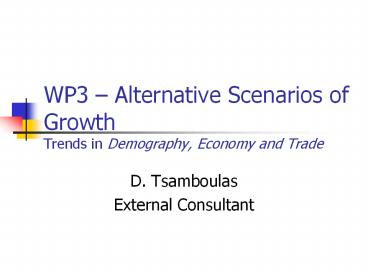WP3%20 - PowerPoint PPT Presentation
Title:
WP3%20
Description:
Trends in Demography, Economy and Trade D. Tsamboulas External Consultant ... Contribution of migration to demographic growth in Group 1 is close to 75%. – PowerPoint PPT presentation
Number of Views:77
Avg rating:3.0/5.0
Title: WP3%20
1
WP3 Alternative Scenarios of GrowthTrends in
Demography, Economy and Trade
- D. Tsamboulas
- External Consultant
2
Socio-economic framework
- Based on existing studies and data available
concerned the economic and social characteristics
of each country,the socio-economic framework of
today was outlined. - TINA Final report
- SCENARIOS Final report
- STAC-TEN Final report
- REBIS Final report
- TIRS Final report
- CODE-TEN Deliverables 4 8
- WORLDBANK DATABASE
- UNECE WEBSITE
3
Table 1 Population, GDP, Exports-Imports (in
2003)
4
Basic assumptions for Socio-economic scenarios
- 2000 as the base year
- data from 1995-2000, 2001, 2002 and 2003 were
employed to establish the trends - where projections were available they were used
- approach to trend analysis in forecasting
involves the use of growth curves
5
Country groups for forecasting
n
6
Demography
- Demography is very much influenced by natural
birth and lately by external migration. - Contribution of migration to demographic growth
in Group 1 is close to 75. - In Group 2, for some years, since 1993, there has
been a demographic decrease. - The demographic evolutions between countries and
within countries show indeed high contrasts
inside Group 1 countries and among the rest. - trend analysis in demography forecasting involved
the use of growth curves
7
Table 2 Population projections for Group 1
countries
8
Table 3 Population projections for Group 2
countries
9
Table 4 Population projections for Group 3
countries
n
10
Economy
- For Group 1, forecasts do exist for the year
2020. - For the rest, extrapolations to the future years
(up to 2020) are made - Assuming that growth rates in the countries of
Group 2 and 3, will gradually converge with
average growth rates in countries of Group 1. - However, it is assumed that they are always
higher than the growth rates in Group 1.
11
Table 5 GDP projections for the Group 1 countries
12
Table 6 GDP projections for the Group 2 countries
13
Table 7 GDP projections for the Group 3 countries
n
14
Foreign trade
- For Group 1
- a falling share of primary goods and bulk
products, - a decreasing share of intermediate goods,
- a rapidly increasing share of the high value
goods. - For Group 2 similar rates of increase for imports
and exports as with countries of Group 1. - more detailed geographic analysis will be
necessary to investigate the potential growth of
trade between neighboring countries in the Baltic
areas, the Central Europe area, the Black sea
area and the Balkans. - The general trend in countries of Group 3 will
follow the trend of Group 2.
15
Table 8 Exports of Goods and Services (index
2000100) projections for Group 1 countries
Table 9 Imports of Goods and Services (index
2000100) projections for Group 1 countries
16
Table 10 Exports of Goods and Services (index
2000100) projections for Group 2 countries
17
Table 11 Imports of Goods and Services (index
2000100) projections for Group 2 countries
18
Table 12 Exports of Goods and Services (index
2000100) projections for Group 3 countries
n
19
Table 13 Imports of Goods and Services (index
2000100) projections for Group 3 countries
n































